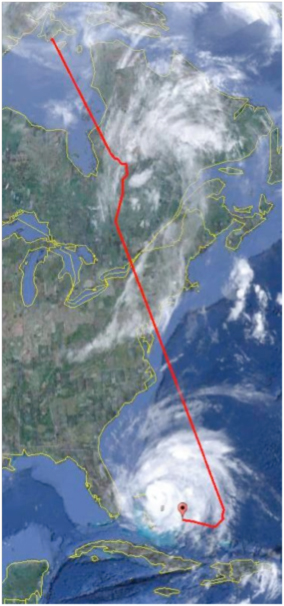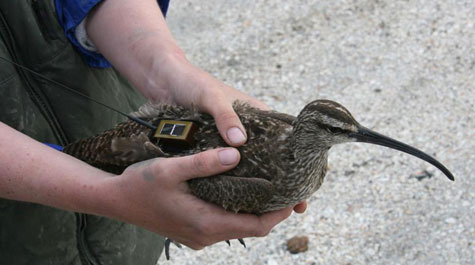Whimbrel successfully negotiates most severe part of Hurricane Irene
Scientists are tracking a migrating shorebird that appears to have survived flying through the most dangerous segment of Hurricane Irene.
The shorebird, a whimbrel named Chinquapin, is migrating from Canada to South America. Bryan Watts, director of William & Mary’s Center for Conservation Biology (CCB), said Chinquapin left upper Hudson Bay on Saturday, flew out over the open ocean and appears to have encountered the outer bands of Irene on Tuesday.
Chinquapin is one of a number of whimbrels being tracked by satellite transmitters they carry as backpacks. This species of bird is noted for extremely long migrations from their far north breeding grounds to wintering grounds in the tropics. Many whimbrels use the tidal creeks and marshes of Virginia’s Eastern Shore as staging grounds, resting and feeding on the abundant crabs there.
 He said tracking revealed that Chinquapin flew through the dangerous northeast quadrant of the storm during the day on Wednesday. Watts added that in 2010, the same bird flew around Tropical Storm Colin while a second bird flew into the storm and did not survive.
He said tracking revealed that Chinquapin flew through the dangerous northeast quadrant of the storm during the day on Wednesday. Watts added that in 2010, the same bird flew around Tropical Storm Colin while a second bird flew into the storm and did not survive.
“We really expect that Chinquapin will probably make it,” Watts said. He added that the bird is now within reach of many of the Caribbean islands and no longer over open ocean.
Early in August, a whimbrel named Hope successfully survived passage through the teeth of Tropical Storm Gert, a rare tropical storm off Nova Scotia. Hope encountered high headwinds for 27 hours, averaging only 9 miles per hour. Once through the storm, her flight speed increased to more than 90 miles per hour as the bird was pushed by significant tail winds and made it back to Cape Cod. Hope now is resting on her Eastern Shore staging grounds.
Watts said that he’s at a loss to explain exactly what makes whimbrels such excellent storm navigators. “It’s pretty amazing that Hope could withstand headwinds for 27 hours,” he said.
How migratory birds navigate around and survive major storm systems is an open question to science. Watts said that achieving an understanding of this process is important because the Caribbean Basin is a major flyway for many bird species moving from breeding grounds in North American to winter in South America. These migrations coincide with the period of highest hurricane formation. Changes in storm frequency, intensity, or distribution may have implications for timing and routes of migratory movements, he added.
This tracking project is a collaborative effort between the Center for Conservation Biology, Georgia Department of Natural Resources, The Nature Conservancy, The U.S. Fish and Wildlife Service, the Virginia Coastal Zone Management Program and Manomet Center for Conservation Sciences.
Watch whimbrel tracking online.















